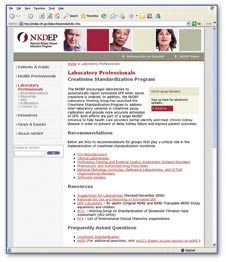Kidney Disease Research Updates
Winter 2007
NKDEP Promotes Use of eGFR to Detect CKD
The National Kidney Disease Education Program (NKDEP) hopes to reduce the number of people in the United States with kidney failure by helping health care providers detect chronic kidney disease (CKD) earlier.
Through the Creatinine Standardization Program, the NKDEP’s Laboratory Working Group is collaborating with the clinical laboratory community to improve the reliability of the serum creatinine measurement. The improved creatinine measurement, in turn, will improve the accuracy of the estimated glomerular filtration rate (eGFR), which is derived from the serum creatinine measurement and is the best measure of kidney function.
Creatinine is a waste product in the blood created by the normal breakdown of muscle cells during activity. When kidneys are not working well, creatinine builds up in the blood.
The glomerular filtration rate (GFR) is a measure of how well kidneys filter wastes from the blood. The NKDEP recommends the GFR be estimated for adults using the Modification of Diet in Renal Disease (MDRD) study prediction equation, which includes a serum creatinine value and values for age, gender, and race.
The Laboratory Professionals section of the NKDEP website provides information about the modified version of the MDRD equation.
Currently, variability in serum creatinine measurements among laboratories renders GFR estimating equations less accurate in the normal and slightly elevated range of serum creatinine concentrations, which is the relevant range for detecting CKD. The Creatinine Standardization Program, as its name implies, intends to facilitate standardization of serum creatinine measurement in labs worldwide.
Modified Equation
When clinical laboratories begin using standardized methods for measuring creatinine, they also will need to start using a modified version of the MDRD equation. The Laboratory Professionals section of the NKDEP website at www.nkdep.nih.gov/labprofessionals has more information about the modified equation. The website also provides health professionals with GFR calculators for estimating kidney function in adults and children.
The Creatinine Standardization Program offers recommendations for, and coordinates communication among, groups that play a role in standardizing creatinine measurement, including in-vitro diagnostic manufacturers, clinical laboratorians, pharmacists, and health care professionals. The website allows these groups to sign up for electronic program updates and find information specific to their needs.
Related Priority
Another goal of the Creatinine Standardization Program is to increase the number of diagnostic labs that routinely report eGFR when serum creatinine is ordered.
“Although eGFR is a superior measure of kidney function, few health care providers are using it or ordering it from diagnostic laboratories, relying instead on serum creatinine, which is frequently misinterpreted,” said Greg Miller, Ph.D., the Working Group’s chair.
“Consequently, providers are failing to detect CKD early, allowing kidney damage to progress without treatment,” Miller continued. “More widespread use and reporting of eGFR would dramatically improve providers’ ability to detect kidney disease, leading to earlier treatment and a likely reduction in the incidence of kidney failure.”
At least 8 million Americans have stage 3 or more advanced CKD, and the number is growing. Many people with CKD develop kidney failure, which cost the nation more than $32.5 billion to treat in 2004.
NIH Publication No. 07–4531
March 2007
[Top]
|






